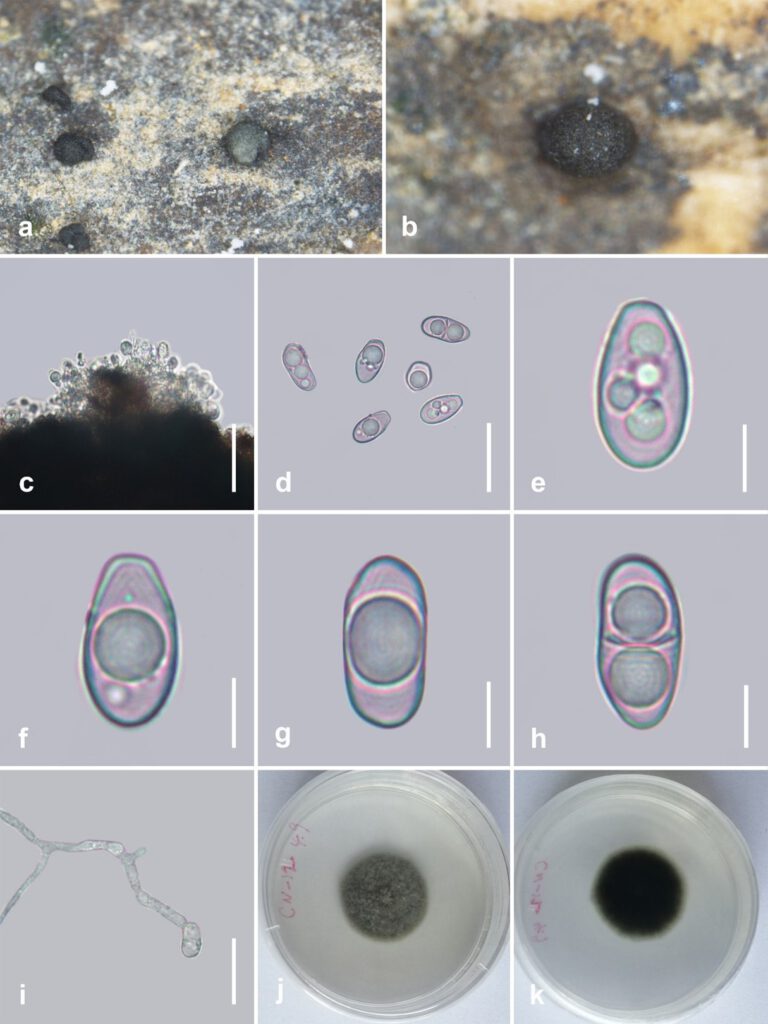Halobyssothecium sichuanense Kunming University of Science and Technology.
MycoBank number: MB 559791; Index Fungorum number: IF 559791; Facesoffungi number: FoF 12672;
Description
Saprobic on decaying wood in freshwater habitats. Sexual morph: Undetermined. Asexual morph: Conidiomata 90–180 µm high, 180–310 µm in diam, pycnidial, scattered, semi-immersed to superficial, ellipsoidal, dark brown to black, unilocular, sometimes white at the top, ostiolate. Conidiomatal wall 19–35μm, composed of thick-walled, dark brown cells of textura angularis. Conidiophores reduced to conidiogenous cells. Conidiogenous cells 3–7 × 2–4 μm, holoblastic, determinate, cylindrical to subcylindrical, aseptate, hyaline, smooth-walled. Conidia 8–15 × 6–8 µm (x̅ = 12.4 × 6.7 μm, n = 20), ellipsoidal to ovoidal, aseptate, rarely 1-septate, hyaline, thin-walled, smooth, with one big guttula or several small ones in each cell.
Material examined: CHINA, Sichuan Province, Yibin, Changning river, on submerged wood (Poaceae), 29 March 2021, Y. Qing (IFRDCC 3121, holotype).
Distribution: China, Sichuan Province
Sequence data: ITS: ON124829 (ITS1/ITS4); LSU: ON124913 (LROR/LR5)
Notes: The phylogenetic result shows that H. sichuanense is a distinct species in Halobyssothecium and closes to a sexual species H. thailandica (Fig. 3). Halobyssothecium bambusicola, H. kunmingense, H. phragmitis and H. unicellulare are also known for asexual morph. Halobyssothecium sichuanense morphologically differs from H. bambusicola and H. phragmitis in conidial shape (ellipsoidal to ovoidal in H. sichuanense vs. globose to obovate in H. bambusicola vs. ovoid to fusoid-ellipsoidal in H. phragmitis) (Calabon et al. 2021); from H. kunmingense in having smaller conidiomata (210–250 μm high vs. 90–180 μm high) (Dong et al. 2020); and from H. unicellulare in having larger conidia (8–15 × 6–8 μm vs. 6–9 × 4–5 μm) and cylindrical to subcylindrical conidiogenous cells as compared to globose, subglobose to pearshaped ones in H. unicellulare (Hyde et al. 2016). All the four known asexual species are phylogenetically distinguished from our new isolate. Therefore, it is introduced as a new species H. sichuanense. The discovery of the new species provided potential possibilities for ecological environment detection, pharmaceutical raw material development and other aspects, and laid a foundation for the subsequent application research.

Fig. 1. Halobyssothecium sichuanense (IFRDCC 3121, holotype). a–b Colonies on substrate. c Developing conidia attach to conidiogenous cell. d–h Conidia. i Germinating conidia on PDA. j Surface view of culture on PDA. k Reverse view of culture on PDA. Scale bar: c = 35 µm, i = 20 µm, d–h = 5 µm.
